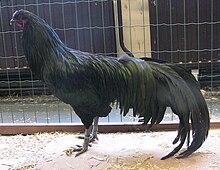Sumatra chicken
 | |
| Conservation status | |
|---|---|
| Other names | |
| Country of origin | Indonesia |
| Distribution |
|
| Use |
|
| Traits | |
| Weight | |
| Egg color | white |
| Comb type | pea |
| Classification | |
| APA | all other standard breeds[4] |
| ABA | all other combs, clean legged |
| EE | yes[5] |
| PCGB | rare soft feather: light[6] |
| |

The Sumatra is a European and North American breed of chicken. It derives from birds imported in the nineteenth century from the island of Sumatra in Indonesia as fighting cocks.
History
The Sumatra derives from birds brought in 1847 from the island of Sumatra in Indonesia to the United States for use as fighting cocks.[7]: 160 It was recognised in the United States in 1883 and in the United Kingdom in 1906.[8]: 305 Birds were imported to Germany from the United States in 1882.[9]: 86
Characteristics
The original colour of the Sumatra was the black – often with a rich beetle-green sheen – which was added to the American Standard of Perfection in 1883, and was standardised in Britain in 1906.[8]: 305 The blue is the only other colour recognised by the American Poultry Association; it was added in 2003.[4]: 18 The Poultry Club of Great Britain recognises black, blue and white,[8]: 306 while the Entente Européenne recognises the black, black-red and wild type but not the blue.[5]
Cocks weigh 2.25–2.70 kg, and hens about 1.80 kg.[3]: 288 The comb is pea-shaped and as small as possible. The beak, face, earlobes, throat, comb, shanks and feet are as dark as possible, preferably black.[8]: 306
The Sumatra retains a strong flying ability, unlike most modern chicken breeds.[7]: 160
Use
The Sumatra may be reared as an ornamental breed or for showing.[citation needed] Hens are good layers of white or cream-coloured eggs, of which they may lay about 130 per year.[8]: 305 [9]: 86 They are very good sitters, and may be used to hatch eggs of other breeds, including water-fowl.[8]: 305
References
- ^ a b Barbara Rischkowsky, Dafydd Pilling (editors) (2007). List of breeds documented in the Global Databank for Animal Genetic Resources, annex to The State of the World's Animal Genetic Resources for Food and Agriculture. Rome: Commission on Genetic Resources for Food and Agriculture, Food and Agriculture Organization of the United Nations. ISBN 9789251057629. Archived 23 June 2020.
- ^ Breed data sheet: Sumatra / United States of America (Chicken). Domestic Animal Diversity Information System of the Food and Agriculture Organization of the United Nations. Accessed August 2024.
- ^ a b c d Victoria Roberts (2008). British Poultry Standards: complete specifications and judging points of all standardized breeds and varieties of poultry as compiled by the specialist breed clubs and recognised by the Poultry Club of Great Britain, sixth edition. Oxford: Blackwell. ISBN 9781405156424.
- ^ a b APA Recognized Breeds and Varieties: As of January 1, 2012. American Poultry Association. Archived 4 November 2017.
- ^ a b Liste des races et variétés homologuée dans les pays EE (28.04.2013). Entente Européenne d'Aviculture et de Cuniculture. Archived 16 June 2013.
- ^ Breed Classification. Poultry Club of Great Britain. Archived 12 June 2018.
- ^ a b Carol Ekarius (2007). Storey's Illustrated Guide to Poultry Breeds. North Adams, Massachusetts: Storey Publishing. ISBN 9781580176675.
- ^ a b c d e f J. Ian H. Allonby, Philippe B. Wilson (editors) (2018). British Poultry Standards: complete specifications and judging points of all standardized breeds and varieties of poultry as compiled by the specialist breed clubs and recognised by the Poultry Club of Great Britain, seventh edition. Chichester; Hoboken, New Jersey: Wiley Blackwell. ISBN 9781119509141.
- ^ a b Rassetafeln: Hühner (in German). Reichenbach, Haselbachtal: Bund Deutscher Rassegeflügelzüchter. Accessed August 2024.
